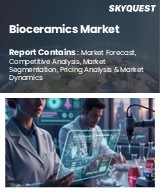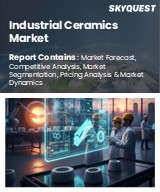
|
시장보고서
상품코드
1610187
반도체 세라믹 시장 보고서 : 동향, 예측 및 경쟁 분석(-2030년)Semiconductor Ceramics Market Report: Trends, Forecast and Competitive Analysis to 2030 |
||||||
반도체 세라믹 동향 및 전망
세계 반도체 세라믹 시장의 미래는 전자 및 반도체, 항공우주, 의료, 산업, 자동차 시장에서의 기회로 인해 유망합니다. 세계 반도체 세라믹 시장은 2024년부터 2030년까지 연평균 7.6%의 성장률을 보일 것으로 예상됩니다. 이 시장의 주요 촉진요인은 와이드 밴드갭 반도체 채택이 증가하고 소형화 및 성능 향상에 대한 수요가 증가함에 따라 시장 성장의 주요 촉진요인이 될 것입니다.
- Lucintel의 예측에 따르면, 유형별로는 질화알루미늄 세라믹이 예측 기간 동안 가장 높은 성장률을 보일 것으로 예상됩니다.
- 용도별로는 전자제품과 반도체가 가장 높은 성장세를 보일 것으로 예상됩니다.
- 지역별로는 아시아태평양이 예측 기간 동안 가장 높은 성장을 보일 것으로 예상됩니다.
반도체 세라믹 시장의 전략적 성장 기회
반도체 세라믹 시장은 다양한 응용 분야에서 수많은 전략적 성장 기회를 제공합니다. 산업계가 첨단 세라믹의 고유한 특성으로 인해 첨단 세라믹을 채택함에 따라, 이해관계자들은 성장을 위한 주요 분야를 파악하는 것이 필수적입니다. 이러한 환경은 기술 발전, 효율적인 재료에 대한 수요 증가, 진화하는 시장 요구에 의해 형성되어 혁신적인 애플리케이션을 위한 비옥한 토양을 조성하고 있습니다.
- 전자 및 소비자 기기 : 전자 분야는 소비자 기기의 고성능 소재에 대한 수요에 힘입어 괄목할 만한 성장을 보이고 있습니다. 반도체 세라믹은 커패시터, 저항기 및 기판에 점점 더 많이 사용되어 장치의 효율성과 소형화를 향상시키고 있습니다. 가전제품이 고도화됨에 따라 내구성과 신뢰성이 높은 세라믹 부품에 대한 수요는 계속 증가할 것이며, 이는 제조업체에게 큰 성장 기회를 제공할 것입니다.
- 재생에너지 기술 : 재생에너지로의 전환은 특히 태양전지 패널과 에너지 저장 시스템에서 반도체 세라믹에 큰 기회를 제공합니다. 첨단 세라믹 소재는 배터리와 태양전지의 효율과 수명을 향상시킬 수 있습니다. 정부와 산업계가 청정에너지에 대한 투자를 늘리면서 혁신적인 세라믹 솔루션에 대한 수요가 증가함에 따라 반도체 세라믹 시장은 지속가능한 노력에 있어 중요한 플레이어로 자리매김할 것입니다.
- 통신 인프라 : 통신 네트워크의 확장, 특히 5G 기술의 등장으로 반도체 세라믹에 대한 수요가 급증하고 있습니다. 이러한 재료는 고주파 애플리케이션에 필수적이며 신호 무결성과 성능을 향상시킵니다. 세계 연결성이 향상됨에 따라 인프라에 대한 투자는 통신 응용 분야에 특화된 세라믹을 전문으로 하는 기업의 성장 기회를 촉진할 것입니다.
- 항공우주 및 국방 : 항공우주 및 국방 분야는 고성능 반도체 세라믹에 독특한 기회를 제공합니다. 이 세라믹은 뛰어난 내구성과 내열성이 요구되는 응용 분야에 사용됩니다. 이러한 재료는 센서, 절연체, 마이크로파 장치와 같은 부품에 필수적입니다. 국방 기술이 발전함에 따라 견고한 세라믹 솔루션에 대한 수요가 증가하여 제조업체에게 유리한 시장 부문을 형성할 것입니다.
- 자동차 전자제품 : 전기자동차 및 자율주행차의 부상으로 자동차 분야는 전력전자 및 열관리 시스템에서 반도체 세라믹에 대한 의존도가 높아지고 있습니다. 이러한 소재는 배터리 성능과 자동차의 신뢰성을 향상시킵니다. 자동차 산업이 전동화로 전환함에 따라 혁신적인 세라믹 솔루션에 대한 수요가 급증할 것으로 예상되며, 이는 이 분야에서 큰 성장 기회를 제공할 것으로 예상됩니다.
이러한 전략적 성장 기회는 주요 응용 분야에서 수요를 촉진하여 반도체 세라믹 시장을 형성하고 있습니다. 산업계가 기술 발전과 지속가능성에 대한 노력에 적응함에 따라, 제조업체들은 혁신적인 기술로 새로운 시장 부문을 확보할 수 있는 잠재력을 가지고 있습니다. 이러한 진화하는 환경은 기존 기술의 성능을 향상시킬 뿐만 아니라, 반도체 세라믹을 다양한 산업의 미래에 중요한 구성요소로 자리매김하고 있습니다.
반도체 세라믹 시장의 촉진요인 및 과제
반도체 세라믹 시장은 다양한 기술적, 경제적, 규제적 요인의 영향을 받아 성장 궤도를 형성하고 있습니다. 산업계가 전자 응용 분야에서 첨단 소재에 대한 의존도가 높아지면서 고성능 세라믹 부품에 대한 수요가 증가하고 있습니다. 동시에 공급망 파괴, 원자재 가격 변동, 규제 변화 등 여러 가지 도전과제가 상황을 더욱 복잡하게 만들고 있습니다. 이러한 역학을 이해하는 것은 이해관계자들이 진화하는 시장에서 기회를 포착하고 위험을 완화하는 데 있어 매우 중요합니다.
반도체 세라믹 시장을 주도하는 요인은 다음과 같습니다.
- 기술의 발전 : 반도체 재료의 끊임없는 혁신은 성능과 효율성을 향상시킵니다. 첨단 세라믹은 우수한 열 안정성과 전기 절연성을 제공하여 최신 전자기기에 필수적인 요소로 자리 잡고 있습니다. 따라서 통신, 자동차 등 높은 신뢰성이 가장 중요한 분야에서 수요가 증가하고 있습니다. 기술의 발전과 함께 특수 세라믹에 대한 수요는 계속 확대될 것입니다.
- 전자기기 수요 확대 : 스마트폰, 노트북, 사물인터넷(IoT) 기기를 중심으로 전 세계 전자제품 소비가 급증하면서 반도체 세라믹 시장이 활기를 띠고 있습니다. 반도체 세라믹은 칩의 소형화 및 효율성 향상에 필수적입니다. 소비자 수요가 증가함에 따라 제조업체는 기술 혁신에 박차를 가하고 있으며, 세라믹 기술에 대한 투자가 증가하여 시장 성장을 뒷받침하고 있습니다.
- 지속가능성 동향 : 환경 규제와 지속가능한 제품에 대한 소비자 선호로 인해 제조업체들은 환경 친화적인 재료로 전환하고 있습니다. 반도체 세라믹은 많은 경우 대체품보다 지속가능성이 높고 친환경 이니셔티브에 부합하는 경우가 많습니다. 이러한 추세는 새로운 시장을 개척할 뿐만 아니라 기업의 명성을 높이고, 기업들이 제품 라인에 세라믹 솔루션을 채택하도록 장려하고 있습니다.
- 신재생에너지 : 재생에너지원의 발전은 에너지 저장 및 변환 시스템에서 반도체 수요를 촉진할 것입니다. 세라믹 소재는 내구성과 효율성으로 인해 태양광발전 및 배터리와 같은 응용 분야에 필수적입니다. 재생 가능 기술에 대한 투자가 확대됨에 따라 반도체 세라믹에 대한 의존도가 높아지고 있으며, 이는 주요 시장 촉진요인으로 작용하고 있습니다.
- 자동차 전자제품의 증가 : 전기자동차(EV)와 첨단 운전자 보조 시스템(ADAS)의 증가는 반도체 세라믹에 대한 수요를 크게 증가시킬 것입니다. 반도체 세라믹은 열악한 환경에서도 높은 성능을 발휘하기 때문에 자동차 애플리케이션에 적합합니다. 자동차 산업이 변화함에 따라, 신뢰성 있고 효율적인 부품에 대한 요구는 세라믹 시장의 지속적인 성장을 보장하고 있습니다.
반도체 세라믹 시장의 과제는 다음과 같습니다.
- 공급망 혼란 : 반도체 산업은 세계 공급망, 특히 원자재 공급망의 혼란으로 인한 취약성에 직면해 있습니다. 이러한 혼란은 생산 일정을 지연시키고, 비용을 상승시키며, 공급 능력을 떨어뜨립니다. 기업은 공급업체를 다변화하고 제조 공정을 최적화하여 회복력을 확보해야 합니다.
- 원재료 가격 변동 : 세라믹에 사용되는 희토류 금속과 같은 원자재 가격 변동은 생산 비용에 영향을 미칠 수 있습니다. 이러한 변동은 재무적 불확실성을 야기하고 소비자 가격 상승으로 이어질 수 있습니다. 제조업체는 이러한 위험을 줄이기 위해 재활용 및 대체품 개발 등 조달 전략에 투자해야 합니다.
- 엄격한 규제 : 전자 및 기타 분야에서 사용되는 재료에 대한 환경 규제 및 표준에 대한 관심이 높아지면서 반도체 세라믹 시장에 도전이 되고 있습니다. 이러한 규제를 준수하는 것은 운영 비용을 증가시키고 사용 가능한 재료의 범위를 제한할 수 있습니다. 기업은 지속적인 시장 진입을 보장하기 위해 변화하는 규제에 대한 정보를 지속적으로 파악해야 합니다.
이러한 도전에도 불구하고, 반도체 세라믹 시장은 기술 발전, 지속가능성 트렌드, 다양한 산업 분야의 수요 증가로 인해 강력한 성장을 이룰 수 있는 위치에 있습니다. 이해관계자들은 이 역동적인 시장의 잠재력을 극대화하기 위해 이러한 도전 과제에 적극적으로 대처해야 합니다.
목차
제1장 주요 요약
제2장 세계의 반도체 세라믹 시장 : 시장 역학
- 소개, 배경, 분류
- 공급망
- 업계 성장 촉진요인과 과제
제3장 2018년부터 2030년까지 시장 동향과 예측 분석
- 거시경제 동향(2018-2023년)과 예측(2024-2030년)
- 세계의 반도체 세라믹 시장 동향(2018-2023년)과 예측(2024-2030년)
- 유형별 : 세계의 반도체 세라믹 시장
- 질화알루미늄 세라믹
- 질화붕소 세라믹
- 탄화규소 세라믹
- 기타
- 용도별 : 세계 반도체 세라믹 시장
- 일렉트로닉스 및 반도체
- 항공우주
- 의료
- 산업
- 자동차
- 기타
제4장 2018년부터 2030년까지 지역별 시장 동향과 예측 분석
- 지역별 반도체 세라믹 세계 시장
- 북미의 반도체 세라믹 시장
- 유럽의 반도체 세라믹 시장
- 아시아태평양의 반도체 세라믹 시장
- 기타 지역의 반도체 세라믹 시장
제5장 경쟁 분석
- 제품 포트폴리오 분석
- 업무 통합
- Porter's Five Forces 분석
제6장 성장 기회와 전략 분석
- 성장 기회 분석
- 유형별 : 세계의 반도체 세라믹 시장 성장 기회
- 용도별 : 세계의 반도체 세라믹 시장 성장 기회
- 지역별 : 세계의 반도체 세라믹 시장 성장 기회
- 세계의 반도체 세라믹 시장 최신 동향
- 전략 분석
- 신제품 개발
- 세계의 반도체 세라믹 시장 생산능력 확대
- 세계의 반도체 세라믹 시장 합병, 인수, 합작투자
- 인증과 라이선싱
제7장 주요 기업 개요
- Aremco Products
- Saint-Gobain Ceramics
- Accumet Materials
- Xiamen Innovacera Advanced Materials
- Mica-Tron Products
- TQ Abrasive Machining
- A C Technologies
- Calix Ceramic Solutions
- Bomas Machine Specialties
- Accuratus
Semiconductor Ceramics Trends and Forecast
The future of the global semiconductor ceramics market looks promising with opportunities in the electronics & semiconductor, aerospace, medical, industrial, and automotive markets. The global semiconductor ceramics market is expected to grow with a CAGR of 7.6% from 2024 to 2030. The major drivers for this market are the increasing demand for miniaturization and performance enhancement, along with the growing adoption of wide bandgap semiconductors.
- Lucintel forecasts that, within the type category, aluminum nitride ceramic is expected to witness the highest growth over the forecast period.
- Within the application category, electronics & semiconductors are expected to witness the highest growth.
- In terms of regions, APAC is expected to witness the highest growth over the forecast period.
Gain valuable insights for your business decisions with our comprehensive 150+ page report.
Emerging Trends in the Semiconductor Ceramics Market
The semiconductor ceramics market is evolving, and several key trends are emerging that will significantly impact the industry. These trends include sustainability, miniaturization, increased demand for electric vehicles, advancements in 5G technology, and innovations in additive manufacturing. Each of these trends is reshaping the landscape of semiconductor ceramics, driving advancements and new applications.
- Sustainability: Sustainability is becoming a critical focus in the semiconductor ceramics market. Companies are developing eco-friendly materials and manufacturing processes that minimize environmental impact. This trend not only addresses regulatory pressures but also meets consumer demand for greener products. By utilizing recycled materials and reducing energy consumption during production, the industry is positioning itself for a more sustainable future.
- Miniaturization: The push for miniaturization in electronics is driving innovations in semiconductor ceramics. As devices become smaller and more powerful, the need for compact and efficient materials grows. This trend is leading to the development of advanced ceramic substrates that enable higher density and performance in electronic circuits. Miniaturization is crucial for applications in mobile devices, IoT, and wearable technology.
- Increased Demand for Electric Vehicles: The rise of electric vehicles (EVs) is significantly impacting the semiconductor ceramics market. Advanced ceramics are essential for improving the performance and efficiency of power electronics used in EVs. This trend is leading to increased research and development investments in high-temperature and high-voltage ceramic materials. As the EV market expands, the demand for reliable semiconductor ceramics will continue to grow.
- Advancements in 5G Technology: The rollout of 5G technology is creating new opportunities for semiconductor ceramics. Higher frequencies require materials with excellent dielectric properties, prompting innovation in ceramic formulations. This trend is crucial for telecommunications infrastructure, where reliability and performance are paramount. As 5G adoption accelerates, the demand for specialized ceramics will rise, driving further advancements in the field.
- Innovations in Additive Manufacturing: Additive manufacturing is revolutionizing the production of semiconductor ceramics. This trend allows for the creation of complex geometries and customized materials that traditional manufacturing methods cannot achieve. Innovations in 3D printing technologies are leading to cost-effective and efficient production processes. As the industry embraces these advancements, the potential for tailored ceramic components will enhance the performance of electronic devices.
These emerging trends are reshaping the semiconductor ceramics market, driving innovation and sustainability. As the industry adapts to new technological demands, it will continue to evolve, creating opportunities for improved materials and processes. The interplay of sustainability, miniaturization, and advancements in technology positions semiconductor ceramics as a critical component in the future of electronics.
Recent Developments in the Semiconductor Ceramics Market
The semiconductor ceramics market is evolving rapidly due to technological advancements and growing demand in various sectors. Innovations in material properties, manufacturing processes, and sustainability initiatives are driving key developments. As industries increasingly adopt high-performance ceramics for applications like electronics, energy storage, and telecommunications, these advancements play a crucial role in enhancing efficiency and reliability. Understanding these developments is essential for stakeholders looking to navigate the changing landscape of semiconductor ceramics.
- Advanced Material Formulations: Recent advancements in material formulations have led to the creation of high-performance ceramics that exhibit superior thermal and electrical properties. This development allows for better heat dissipation in electronic devices, enhancing their reliability and lifespan. These improved materials are increasingly being used in high-frequency applications, paving the way for more efficient and compact electronic components. As manufacturers adopt these advanced materials, the overall performance of semiconductor devices is significantly enhanced.
- Sustainability Initiatives: The push for sustainability has prompted companies to focus on eco-friendly manufacturing processes and materials. Developments include the use of recycled materials in ceramic production and energy-efficient manufacturing techniques. This not only reduces the carbon footprint but also addresses regulatory demands for greener practices. As sustainability becomes a core value, companies that prioritize eco-friendly approaches are likely to gain a competitive edge in the market.
- Integration of AI in R&D: The integration of artificial intelligence (AI) in research and development has transformed how semiconductor ceramics are designed and tested. AI-driven simulations allow for rapid material discovery and optimization, reducing the time and costs associated with traditional methods. This development enhances innovation and enables manufacturers to create tailored solutions that meet specific application needs, ultimately accelerating the development cycle for new products.
- Expansion in 5G Applications: With the rollout of 5G technology, there has been a marked increase in demand for specialized semiconductor ceramics that can handle higher frequencies and greater data transmission needs. Recent developments focus on optimizing dielectric properties in ceramics, which are crucial for telecommunications infrastructure. This growth in 5G applications drives the market, prompting investments in research to enhance the performance of ceramic materials, leading to more efficient communication networks.
- Growth in Electric Vehicle Technologies: The rise of electric vehicles (EVs) has spurred significant developments in semiconductor ceramics, particularly in power electronics. Advanced ceramics are essential for improving battery efficiency and thermal management in EVs. As automakers strive for better performance and longer ranges, the demand for reliable ceramic components is increasing. This trend not only enhances vehicle performance but also positions semiconductor ceramics as a vital component in the transition to sustainable transportation.
These recent developments are reshaping the semiconductor ceramics market by enhancing material properties, promoting sustainability, and driving innovation. The integration of advanced materials and technologies fosters new applications, while the focus on environmental responsibility is creating a more competitive landscape. Overall, these trends contribute to the growth and evolution of the semiconductor ceramics sector, meeting the demands of an increasingly technology-driven world.
Strategic Growth Opportunities for Semiconductor Ceramics Market
The semiconductor ceramics market presents numerous strategic growth opportunities across various applications. As industries adopt advanced ceramics for their unique properties, identifying key areas for growth is essential for stakeholders. This landscape is shaped by technological advancements, rising demand for efficient materials, and evolving market needs, which create fertile ground for innovative applications.
- Electronics and Consumer Devices: The electronics sector is experiencing significant growth, driven by the demand for high-performance materials in consumer devices. Semiconductor ceramics are increasingly used in capacitors, resistors, and substrates, enhancing device efficiency and miniaturization. As consumer electronics become more advanced, the need for durable and reliable ceramic components will continue to rise, presenting substantial growth opportunities for manufacturers.
- Renewable Energy Technologies: The transition to renewable energy sources offers considerable opportunities for semiconductor ceramics, particularly in solar panels and energy storage systems. Advanced ceramic materials improve the efficiency and lifespan of batteries and photovoltaic cells. As governments and industries invest more in clean energy, the demand for innovative ceramic solutions will likely grow, positioning the semiconductor ceramics market as a key player in sustainability efforts.
- Telecommunications Infrastructure: The expansion of telecommunications networks, especially with the advent of 5G technology, is creating a surge in demand for semiconductor ceramics. These materials are essential for high-frequency applications, enhancing signal integrity and performance. As global connectivity improves, investments in infrastructure will drive growth opportunities for companies specializing in ceramics tailored for telecom applications.
- Aerospace and Defense: The aerospace and defense sectors present unique opportunities for high-performance semiconductor ceramics, which are used in applications requiring exceptional durability and thermal resistance. These materials are critical in components such as sensors, insulators, and microwave devices. As defense technologies advance, the demand for robust ceramic solutions will rise, creating a lucrative market segment for manufacturers.
- Automotive Electronics: With the rise of electric and autonomous vehicles, the automotive sector is increasingly reliant on semiconductor ceramics for power electronics and thermal management systems. These materials enhance battery performance and vehicle reliability. As the automotive industry transitions toward electrification, the demand for innovative ceramic solutions is expected to soar, providing significant growth opportunities in this application.
These strategic growth opportunities are shaping the semiconductor ceramics market by driving demand across key applications. As industries adapt to technological advancements and sustainability initiatives, manufacturers have the potential to innovate and capture new market segments. This evolving landscape not only enhances the performance of existing technologies but also positions semiconductor ceramics as a crucial component in the future of various industries.
Semiconductor Ceramics Market Driver and Challenges
The semiconductor ceramics market is influenced by a range of technological, economic, and regulatory factors that shape its growth trajectory. As industries increasingly rely on advanced materials for electronic applications, the demand for high-performance ceramic components rises. Simultaneously, challenges such as supply chain disruptions, fluctuating raw material prices, and evolving regulations complicate the landscape. Understanding these dynamics is crucial for stakeholders to navigate opportunities and mitigate risks in this evolving market.
The factors responsible for driving the semiconductor ceramics market include:
- Technological Advancements: Continuous innovation in semiconductor materials enhances performance and efficiency. Advanced ceramics provide superior thermal stability and electrical insulation, making them essential in modern electronic devices. This drives demand in sectors like telecommunications and automotive, where high reliability is paramount. As technology evolves, the need for specialized ceramics will continue to expand.
- Growing Demand for Electronics: The global surge in electronics consumption, particularly in smartphones, laptops, and IoT devices, fuels the semiconductor ceramics market. These ceramics are critical for miniaturization and efficiency improvements in chips. As consumer demand escalates, manufacturers are compelled to innovate, leading to increased investments in ceramic technology, which supports market growth.
- Sustainability Trends: Environmental regulations and consumer preferences for sustainable products are pushing manufacturers towards eco-friendly materials. Semiconductor ceramics are often more sustainable than their alternatives, aligning with green initiatives. This trend not only opens new markets but also enhances corporate reputation, prompting companies to adopt ceramic solutions in their product lines.
- Renewable Energy: The push for renewable energy sources drives demand for semiconductors in energy storage and conversion systems. Ceramic materials are integral in applications like photovoltaics and batteries due to their durability and efficiency. As investments in renewable technologies grow, so does the reliance on semiconductor ceramics, making this a key market driver.
- Increasing Automotive Electronics: The rise of electric vehicles (EVs) and advanced driver-assistance systems (ADAS) significantly boosts demand for semiconductor ceramics. These materials offer high performance in harsh environments, making them ideal for automotive applications. As the automotive sector transforms, the need for reliable and efficient components ensures continued growth in the ceramics market.
Challenges in the semiconductor ceramics market are:
- Supply Chain Disruptions: The semiconductor industry faces vulnerabilities due to global supply chain disruptions, particularly for raw materials. These disruptions can delay production timelines, increasing costs and reducing availability. Companies must adapt by diversifying suppliers and optimizing manufacturing processes to ensure resilience.
- Raw Material Price Fluctuations: The price volatility of raw materials, such as rare earth metals used in ceramics, can impact production costs. This fluctuation creates financial uncertainty and can lead to higher prices for consumers. Manufacturers must invest in sourcing strategies to mitigate these risks, such as recycling or developing alternatives.
- Stringent Regulations: The growing focus on environmental regulations and standards for materials used in electronics and other sectors presents challenges for the semiconductor ceramics market. Compliance with these regulations can increase operational costs and limit the range of materials available. Companies must stay informed of changing regulations to ensure continued market access.
Despite these challenges, the semiconductor ceramics market is positioned for strong growth, driven by advancements in technology, sustainability trends, and increasing demand across various industries. Stakeholders must address these challenges proactively to unlock the full potential of this dynamic market.
List of Semiconductor Ceramics Companies
Companies in the market compete on the basis of product quality offered. Major players in this market focus on expanding their manufacturing facilities, R&D investments, infrastructural development, and leverage integration opportunities across the value chain. Through these strategies semiconductor ceramics companies cater increasing demand, ensure competitive effectiveness, develop innovative products & technologies, reduce production costs, and expand their customer base. Some of the semiconductor ceramics companies profiled in this report include-
- Aremco Products
- Saint-Gobain Ceramics
- Accumet Materials
- Xiamen Innovacera Advanced Materials
- Mica-Tron Products
- TQ Abrasive Machining
- A C Technologies
- Calix Ceramic Solutions
- Bomas Machine Specialties
- Accuratus
Semiconductor Ceramics by Segment
The study includes a forecast for the global semiconductor ceramics market by type, application, and region.
Semiconductor Ceramics Market by Type [Analysis by Value from 2018 to 2030]:
- Aluminum Nitride Ceramics
- Boron Nitride Ceramics
- Silicon Carbide Ceramics
- Others
Semiconductor Ceramics Market by Application [Analysis by Value from 2018 to 2030]:
- Electronics & Semiconductors
- Aerospace
- Medical
- Industrial
- Automotive
- Others
Semiconductor Ceramics Market by Region [Analysis by Value from 2018 to 2030]:
- North America
- Europe
- Asia Pacific
- The Rest of the World
Country Wise Outlook for the Semiconductor Ceramics Market
The semiconductor ceramics market has experienced significant advancements due to the increasing demand for high-performance materials in electronics. Key players in the United States, China, Germany, India, and Japan are investing in research and development to enhance material properties, reduce manufacturing costs, and improve the sustainability of production processes. This evolving landscape is driven by technological innovations and the need for efficient energy solutions, shaping the future of electronics across various sectors.
- United States: In the U.S., recent developments focus on integrating advanced ceramics in microelectronics. Companies are enhancing material properties such as thermal stability and electrical conductivity. The rise of electric vehicles (EVs) has spurred demand for semiconductor ceramics in power electronics. Furthermore, collaborations between universities and industries are fostering innovation, particularly in developing materials that can withstand extreme environments.
- China: The Chinese semiconductor ceramics market is booming, fueled by government investments and the push for self-sufficiency in technology. Key advancements include developing high-performance dielectric ceramics that improve device efficiency. Chinese manufacturers are also ramping up production capacity to meet the growing domestic demand, particularly in telecommunications and renewable energy sectors. Research initiatives are exploring nanostructured ceramics, aiming to enhance performance in advanced electronic applications.
- Germany: Germany is leading in the development of environmentally friendly semiconductor ceramics, focusing on sustainability in production processes. Innovations include using recycled materials in ceramic fabrication, and minimizing waste. The automotive industry's shift toward electric drivetrains is driving demand for robust semiconductor materials. German research institutions are collaborating with industries to improve the performance of ceramics, specifically in thermal management applications.
- India: India is witnessing a surge in semiconductor ceramics research, driven by the growing electronics market. Investments in local manufacturing and research initiatives aim to enhance material properties and production efficiencies. Key advancements include developing low-cost ceramic substrates for electronic circuits. The government's "Make in India" initiative is supporting startups and SMEs to innovate in semiconductor ceramics, aiming to reduce reliance on imports.
- Japan: Japan remains a leader in precision ceramics, focusing on high-performance applications in consumer electronics and industrial machinery. Recent developments include innovations in dielectric ceramics that enhance signal integrity and reduce energy loss. Japanese firms are investing in AI and machine learning to optimize production processes and material development. Collaborative efforts between academia and industry are key in advancing next-generation semiconductor ceramics that meet evolving market demands.
Features of the Global Semiconductor Ceramics Market
Market Size Estimates: Semiconductor ceramics market size estimation in terms of value ($B).
Trend and Forecast Analysis: Market trends (2018 to 2023) and forecast (2024 to 2030) by various segments and regions.
Segmentation Analysis: Semiconductor ceramics market size by type, application, and region in terms of value ($B).
Regional Analysis: Semiconductor ceramics market breakdown by North America, Europe, Asia Pacific, and Rest of the World.
Growth Opportunities: Analysis of growth opportunities in different types, applications, and regions for the semiconductor ceramics market.
Strategic Analysis: This includes M&A, new product development, and competitive landscape of the semiconductor ceramics market.
Analysis of competitive intensity of the industry based on Porter's Five Forces model.
If you are looking to expand your business in this or adjacent markets, then contact us. We have done hundreds of strategic consulting projects in market entry, opportunity screening, due diligence, supply chain analysis, M & A, and more.
This report answers following 11 key questions:
- Q.1. What are some of the most promising, high-growth opportunities for the semiconductor ceramics market by type (aluminum nitride ceramics, boron nitride ceramics, silicon carbide ceramics, and others), application (electronics & semiconductors, aerospace, medical, industrial, automotive, and others), and region (North America, Europe, Asia Pacific, and the Rest of the World)?
- Q.2. Which segments will grow at a faster pace and why?
- Q.3. Which region will grow at a faster pace and why?
- Q.4. What are the key factors affecting market dynamics? What are the key challenges and business risks in this market?
- Q.5. What are the business risks and competitive threats in this market?
- Q.6. What are the emerging trends in this market and the reasons behind them?
- Q.7. What are some of the changing demands of customers in the market?
- Q.8. What are the new developments in the market? Which companies are leading these developments?
- Q.9. Who are the major players in this market? What strategic initiatives are key players pursuing for business growth?
- Q.10. What are some of the competing products in this market and how big of a threat do they pose for loss of market share by material or product substitution?
- Q.11. What M&A activity has occurred in the last 5 years and what has its impact been on the industry?
Table of Contents
1. Executive Summary
2. Global Semiconductor Ceramics Market : Market Dynamics
- 2.1: Introduction, Background, and Classifications
- 2.2: Supply Chain
- 2.3: Industry Drivers and Challenges
3. Market Trends and Forecast Analysis from 2018 to 2030
- 3.1. Macroeconomic Trends (2018-2023) and Forecast (2024-2030)
- 3.2. Global Semiconductor Ceramics Market Trends (2018-2023) and Forecast (2024-2030)
- 3.3: Global Semiconductor Ceramics Market by Type
- 3.3.1: Aluminum Nitride Ceramics
- 3.3.2: Boron Nitride Ceramics
- 3.3.3: Silicon Carbide Ceramics
- 3.3.4: Others
- 3.4: Global Semiconductor Ceramics Market by Application
- 3.4.1: Electronics & Semiconductors
- 3.4.2: Aerospace
- 3.4.3: Medical
- 3.4.4: Industrial
- 3.4.5: Automotive
- 3.4.6: Others
4. Market Trends and Forecast Analysis by Region from 2018 to 2030
- 4.1: Global Semiconductor Ceramics Market by Region
- 4.2: North American Semiconductor Ceramics Market
- 4.2.1: North American Semiconductor Ceramics Market by Type: Aluminum Nitride Ceramics, Boron Nitride Ceramics, Silicon Carbide Ceramics, and Others
- 4.2.2: North American Semiconductor Ceramics Market by Application: Electronics & Semiconductors, Aerospace, Medical, Industrial, Automotive, and Others
- 4.3: European Semiconductor Ceramics Market
- 4.3.1: European Semiconductor Ceramics Market by Type: Aluminum Nitride Ceramics, Boron Nitride Ceramics, Silicon Carbide Ceramics, and Others
- 4.3.2: European Semiconductor Ceramics Market by Application: Electronics & Semiconductors, Aerospace, Medical, Industrial, Automotive, and Others
- 4.4: APAC Semiconductor Ceramics Market
- 4.4.1: APAC Semiconductor Ceramics Market by Type: Aluminum Nitride Ceramics, Boron Nitride Ceramics, Silicon Carbide Ceramics, and Others
- 4.4.2: APAC Semiconductor Ceramics Market by Application: Electronics & Semiconductors, Aerospace, Medical, Industrial, Automotive, and Others
- 4.5: ROW Semiconductor Ceramics Market
- 4.5.1: ROW Semiconductor Ceramics Market by Type: Aluminum Nitride Ceramics, Boron Nitride Ceramics, Silicon Carbide Ceramics, and Others
- 4.5.2: ROW Semiconductor Ceramics Market by Application: Electronics & Semiconductors, Aerospace, Medical, Industrial, Automotive, and Others
5. Competitor Analysis
- 5.1: Product Portfolio Analysis
- 5.2: Operational Integration
- 5.3: Porter's Five Forces Analysis
6. Growth Opportunities and Strategic Analysis
- 6.1: Growth Opportunity Analysis
- 6.1.1: Growth Opportunities for the Global Semiconductor Ceramics Market by Type
- 6.1.2: Growth Opportunities for the Global Semiconductor Ceramics Market by Application
- 6.1.3: Growth Opportunities for the Global Semiconductor Ceramics Market by Region
- 6.2: Emerging Trends in the Global Semiconductor Ceramics Market
- 6.3: Strategic Analysis
- 6.3.1: New Product Development
- 6.3.2: Capacity Expansion of the Global Semiconductor Ceramics Market
- 6.3.3: Mergers, Acquisitions, and Joint Ventures in the Global Semiconductor Ceramics Market
- 6.3.4: Certification and Licensing
7. Company Profiles of Leading Players
- 7.1: Aremco Products
- 7.2: Saint-Gobain Ceramics
- 7.3: Accumet Materials
- 7.4: Xiamen Innovacera Advanced Materials
- 7.5: Mica-Tron Products
- 7.6: TQ Abrasive Machining
- 7.7: A C Technologies
- 7.8: Calix Ceramic Solutions
- 7.9: Bomas Machine Specialties
- 7.10: Accuratus
(주말 및 공휴일 제외)


















